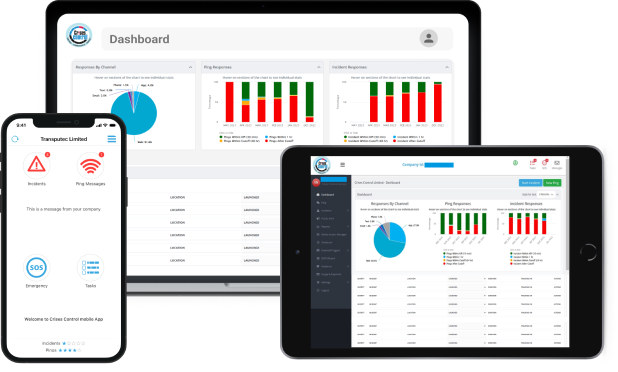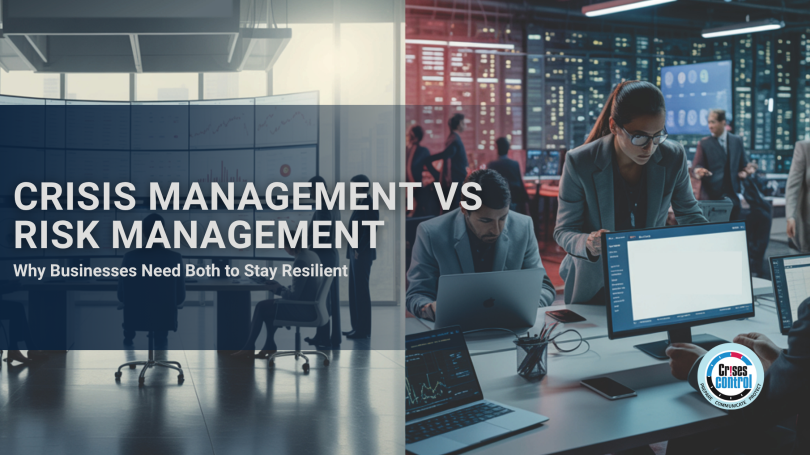Written by Chanay Blomkamp | Crises Control Marketing Assistant
The Real Cost of Confusing Planning with Action
Let’s say your company has a comprehensive risk register. You’ve listed potential threats, rated them by impact and likelihood, and created mitigation strategies. Everything looks good on paper. Then, a real incident strikes. A ransomware attack locks up your systems. Customers can’t reach you. Staff don’t know what to do. Suddenly, your risk register offers little help.
The problem? Planning for what might happen is not the same as responding when it does. That’s the core difference between risk management and crisis management, and why treating them as the same can lead to chaos.
This blog explains the difference between the two, shows why both are essential, and highlights how Crises Control helps bridge the gap. We’ll break it down clearly, without jargon, and give you practical steps to improve your business resilience.
What Is Risk Management and What Does It Cover?
Risk management helps you prepare for potential issues before they happen. It’s about spotting threats to your business and working out how to prevent or minimise them. These might include IT outages, supply chain disruption, compliance failures or reputational risks.
Key parts of risk management include:
- Identifying risks that could affect your business
- Evaluating how likely each risk is, and what damage it could cause
- Putting controls or plans in place to reduce those risks
- Reviewing and updating those plans regularly
Risk management is usually handled by dedicated teams or part of a compliance function. It’s vital for long-term planning and helps organisations avoid trouble before it begins.
But no matter how good your plans are, things still go wrong. That’s where crisis management comes in.
What Is Crisis Management and How Is It Different?
Crisis management kicks in after something has already gone wrong. It’s not about spotting problems ahead of time, but about responding quickly and effectively when the unexpected happens.
This could be a serious data breach, a natural disaster, or an incident that puts people at risk. In these situations, speed and clarity matter more than perfect plans. Your team needs to know what to do, who to tell, and how to limit the damage.
Crisis management focuses on:
- Communicating fast with staff, customers and stakeholders
- Activating emergency plans
- Making decisions under pressure
- Recovering quickly and learning from what happened
While risk management is often slow and deliberate, crisis management is fast, focused and action-led. The teams involved are different too. Crisis management needs input from across the business, not just the risk or compliance team.
So, what is the difference between crisis management and risk management in business? Risk management is about what could go wrong and how to reduce the chance of it happening. Crisis management is about what happens next when it does.
Why Mixing Up the Two Can Leave You Exposed
If your organisation has detailed risk plans but no live response capability, you might feel secure, until something goes wrong. Too many businesses rely on static risk documents but have no tested plan to communicate or coordinate during a real crisis.
This confusion often leads to delays, missed messages, and poor decisions under pressure. Staff are unsure who is in charge or what action to take. Leadership teams may not be alerted in time. The fallout can be serious, lost revenue, damaged reputation, or even legal consequences.
Having both risk and crisis management in place means you’re covered on all sides. You’ve planned for problems, and you’re ready to act when they happen.
Side-by-Side: Risk vs Crisis Management
Here’s a simple comparison of the two approaches:
| Area | Risk Management | Crisis Management |
| Timing | Before a problem happens | During or after a problem |
| Focus | Planning and prevention | Fast response and recovery |
| Teams involved | Risk, legal, compliance | Ops, comms, HR, IT, leadership |
| Activities | Assessing risks, creating controls | Communicating, activating plans, decision-making |
| Success looks like | Fewer problems happening | Reduced impact when problems do happen |
| Tools used | Risk registers, dashboards | Mass alerting, incident response systems |
Both are essential. But they work best when they work together.
How Crises Control Connects Risk Awareness to Real-Time Action
Crises Control is designed to fill the gap between knowing a risk and taking action when it becomes real. It doesn’t replace your existing risk tools. It turns your risk plans into response plans.
Link Risk to Response
If a cyber threat becomes a breach, Crises Control helps you launch the right incident plan instantly. You can link risk scenarios directly to workflows, so you’re not starting from scratch in a crisis.
Notify Everyone, Fast
Crises Control sends emergency messages across multiple channels at once, mobile app, email, SMS, voice call, and more. Everyone gets the message, even if they’re out of office or offline.
Escalate to the Right People
Not every incident needs the same response. Crises Control routes alerts based on severity, type and location. It ensures the right people are involved straight away, avoiding confusion or duplication.
Keep Records Automatically
Every message, decision and update is logged. After the crisis, you’ve got a full audit trail to support reviews, compliance and learning.
Works With What You Already Use
Crises Control can plug into your existing tools and platforms. It supports integration with risk management systems so you can connect the dots between risk planning and crisis execution.
Why Separating and Connecting, These Roles Is Critical
Risk and crisis management serve different purposes. Risk management helps you avoid trouble. Crisis management helps you survive it. Having one without the other creates blind spots.
By treating them as separate but connected, you create a more complete resilience strategy. It means:
- You reduce the chances of serious problems occurring
- You respond faster and smarter when they do
- You protect people, operations and your reputation
Crises Control gives you the tools to make that connection possible. It brings together risk awareness and crisis readiness in a single platform that works when it matters.
What You Can Do Now
If you’re a manager looking to improve your organisation’s readiness, here are a few starting points:
- Look at your top risks, do you have matching response plans?
- Review your crisis procedures, could you activate them in minutes?
- Run a tabletop exercise, simulate a crisis and see how people respond
- Assess your technology, can you reach everyone quickly and track what happens?
- Ask whether your teams are trained to take action under pressure
If any of these steps highlight a gap, you’re not alone and it’s solvable.
Conclusion: Being Ready Takes More Than Just a Plan
A solid risk register is a great start. But without a tested crisis response, it’s not enough. True resilience means being ready to act when things go wrong, not just knowing what could go wrong.
Understanding the difference between risk and crisis management helps you prepare properly and respond confidently. Crises Control provides the technology that links the two, turning insight into action.
Book your free demo today and see how Crises Control can help you stay in control when it matters most.
Contact us for a free demo and find out how we help turn risk awareness into real resilience.
Request a FREE Demo

